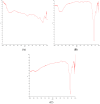Bacteria inside semiconductors as potential sensor elements: biochip progress
- PMID: 24961215
- PMCID: PMC4118370
- DOI: 10.3390/s140611225
Bacteria inside semiconductors as potential sensor elements: biochip progress
Abstract
It was discovered at the beginning of this Century that living bacteria-and specifically the extremophile Pseudomonas syzgii-could be captured inside growing crystals of pure water-corroding semiconductors-specifically germanium-and thereby initiated pursuit of truly functional "biochip-based" biosensors. This observation was first made at the inside ultraviolet-illuminated walls of ultrapure water-flowing semiconductor fabrication facilities (fabs) and has since been, not as perfectly, replicated in simpler flow cell systems for chip manufacture, described here. Recognizing the potential importance of these adducts as optical switches, for example, or probes of metabolic events, the influences of the fabs and their components on the crystal nucleation and growth phenomena now identified are reviewed and discussed with regard to further research needs. For example, optical beams of current photonic circuits can be more easily modulated by integral embedded cells into electrical signals on semiconductors. Such research responds to a recently published Grand Challenge in ceramic science, designing and synthesizing oxide electronics, surfaces, interfaces and nanoscale structures that can be tuned by biological stimuli, to reveal phenomena not otherwise possible with conventional semiconductor electronics. This short review addresses only the fabrication facilities' features at the time of first production of these potential biochips.
Figures









References
-
- Sah V.R. Master's Thesis. State University of New York at Buffalo; Buffalo, NY, USA: 2013. Ultra-pure Water and Extremophilic Bacteria Interactions with Germanium Surfaces.
-
- McAllister M.B., Kulakov L.A., O'Hanlon J.F., Larkin M.J., Ogden K.L. Survival and Nutritional Requirements of Three Bacteria Isolated from Ultrapure Water. J. Ind. Microbiol. Biotechnol. 2002;29:75–82. - PubMed
-
- Baier R.E., DePalma V.A. Flow Cell and Method for Continuously Monitoring Deposits on Flow Surfaces. U.S. Patent 4,175,233. 1979
-
- Baier R.E., Meyer A.E., DePalma V.A., King R.W., Fornalik M.S. Surface Microfouling During the Induction Period. J. Heat Transf. 1983;105:618–624.
-
- Jeon J.S., Raghavan S. Adsorption behavior of nonionic surfactants onto silicon. In: Heyns M., Meuris M., Mertens P., editors. Proceedings of the Second International Symposium on Ultra-clean processing of silicon surfaces; University of California, CA, USA. 1994. pp. 323–326. Acco Leuven/Amersfoort, 1994.
Publication types
MeSH terms
LinkOut - more resources
Full Text Sources
Other Literature Sources

